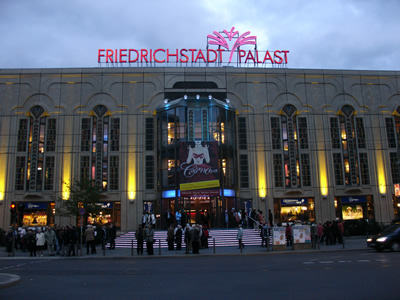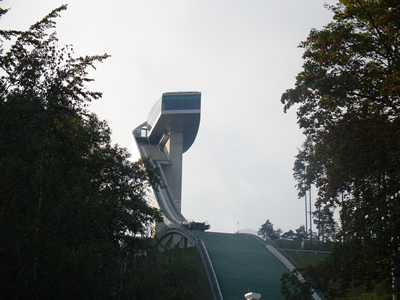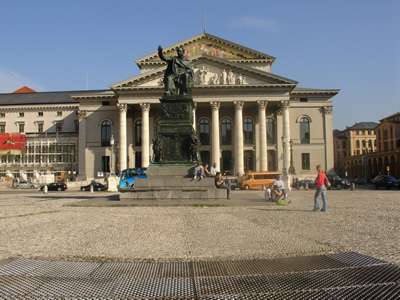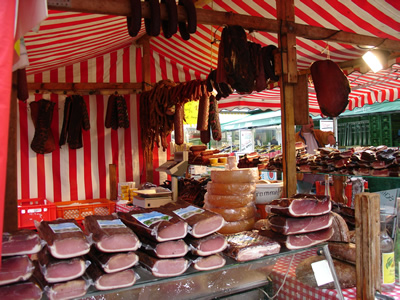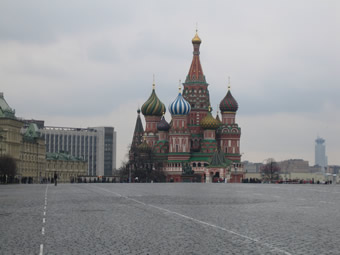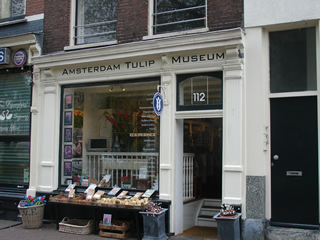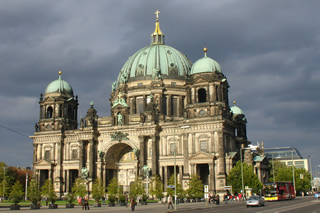Today, it is often hard to imagine the extent of destruction suffered by some European cities during World War II. While most cities and towns were quickly rebuilt after the war, one village has been preserved as a memorial to the victims who once lived there. Read the rest of this entry »
Posts under ‘Europe’
Spend the night at a nazi resort
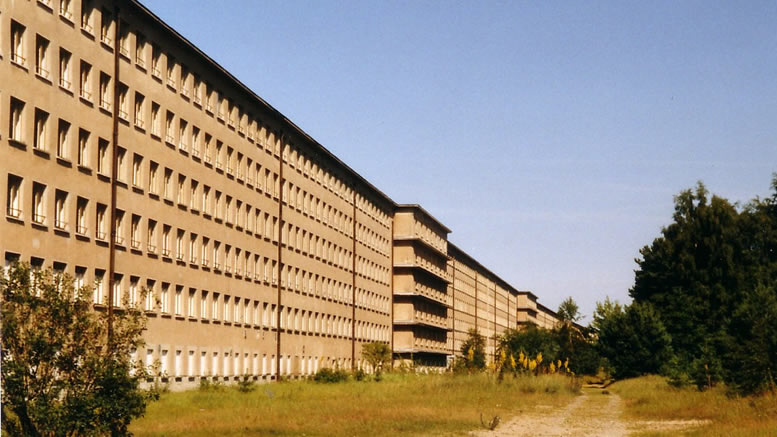
A bit of a follow-up on the Prora Resort story we covered back in 2008. To recap, the Prora resort was built by the Nazis under Hitler’s Kraft durch Freude (Strength Through Joy) program, designed to provide affordable holidays for 20,000 workers at a time. As part of his propaganda efforts, Hitler used grandiose projects like Prora to rally public support for his regime, showcasing the supposed benefits of his leadership. Read the rest of this entry »
Friedrichstadt Palast in Berlin
The Friedrichstadt-Palast is one of Berlin’s most iconic revue theatres, located in the heart of the Mitte district. Originally opened in 1867, the theatre has undergone numerous transformations and rebuilds over the years, reflecting the evolving tastes and demands of entertainment. The current building, completed in 1984, is a modern marvel and a testament to Berlin’s post-war cultural revival. Read the rest of this entry »
The Bergiselschanze
A spectacular landmark in the Austrian city of Innsbruck is the Bergiselschanze ski jump on the Bergisel Hill. The huge concrete and glass structure was built in 2001 and the current form was designed by Iraqi architect, Zaha Hadid at a cost of €15 million. The actual Bergiselschanze dates back to the 1930’s. There is a cafe at the top which offers amazing views of Innsbruck and the surrounding villages on a clear day. The jump hosts the annual prestigious Four Hills Tournament’ third leg and the mountain has played host to two Winter Olympic Games, the 1964 games and the 1976 games. The Bergisel can be easily reached by the Stubaitalbahn from Innsbruck.
Munich’s Opera House
The thought of beer and sausages yesterday made me want to do another Munich story today. So thought I would talk about the National Theatre building which is on Max-Joseph Platz 2. Used as an Opera House it has seating for 2100 people complete with a royal box and circular auditorium. The theatre is home to the Bavarian State Ballet and Bavarian State Opera who hold regular performances at the magnificent venue. It was destroyed in World War II bombing but rebuilt and the current building opened in 1963. The opera house has had a huge list of world premiers including works by Wagner, Strauss to name just two. For visitors not able to take in a show the theatre has hour long tours of the venue which happen most days at 2pm. It is a great chance to see one of the finest opera houses in the world so rich in history and tradition.
The Viktualienmarkt
Just a short distance from the Munich’s main square the Marienplaz is a fantastic open air market callde the Viktualienmarkt. This market is basically a food market selling all sorts of fresh foods including fish, meat, cheese, fruit and vegetables. But the market is also a great meeting place to enjoy the sausages and beer. And belive me Munich has the best sausages and beer you will find anywhere in the world. It is imposible to stop at one as the they are just so delicious. The market has penty of seating so you can enyoy the festivities, food, drink and atmosphere for hours- not a bad way to fill in a sunny afternoon in Munich. The market opens 6 days a week being closed on Sundays.
Moscow’s Magnificent
Saint Basil’s or the Cathedral of Intercession of Theotokos on the Moat is probably the most known piece of architecture in Moscow. This magnificently coloured cathedral with its onion like domes is one of the world’s great religious buildings. The church celebrates Russian Orthodox and its beginnings date back to 1555 although the vivid colours and architecture were not a feature until the 1680’s and happened in stages over nearly 200 years. The building is meant to be inspired by a bonfire and its architecture is so unique there were no known similarities to it anywhere. It is rumoured that the architect Postnik Yakovlev was blinded by Ivan the Terrible so he would not design anything as magnificent ever again. The building today is part of the UNESCO World Heritage Site which includes the two other major Moscow landmarks Red Square and the Kremlin. The cathedral has been pretty lucky to survive until today. Napoleon was so taken with the St Basil’s that he wanted to dismantle it and move it to Paris but legend tells he didn’t have the technology or manpower to do it. Unhappy with Russia having it and not Paris he then decided no one should have it and ordered it to be blown up. The story goes a sudden shower extinguished the gun powder fuses and the cathedral was saved. St Basil’s was nearly lost in the 1930’s too. Stalin’s Red Square development team planned to knock the structure down to make way for a new grand square luckily the plan didn’t come to fruition. Read the rest of this entry »
Amsterdam’s Tulip Museum Shop
Well forgetting the dope smoking, the canals and of course the tasty Heineken nothing symbolises Amsterdam like the Tulip and no visit to this fascinating European city is complete without a visit to the Amsterdam Tulip Museum. Located at Prinsengracht 112 beside the canal and in easy walking distance of Central Station and many of the major city sights. The museum shop has a wonderful array of bulbs, flowers and everything tulip. There are some lovely souvenirs, books, prints and even specialised gardening tools and equipment. The perfect place to pick up some mementos from Holland for your friends back home. The museum will send bulbs by post overseas but please check with your friendly customs people before ordering to see if there are any restrictions on importing bulbs into your country. Tulip Bulbs are usually available around September through to the end of the year but many other varieties are available at other times.
Prague’s Trams
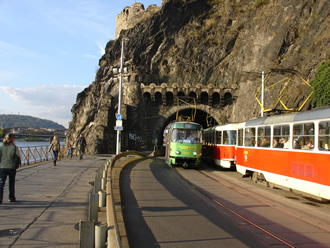
The beautiful Czech Republic city of Prague has a wonderful tram network which makes visiting the city very easy. The trams in the city date back to 1875 when the trams were horse drawn but today the system is one of the most modern in Europe and covers over 140 kilometres of track and over 900 tram cars. For a real treat look out for the historic no 91 tram which runs over the warmer months. This quaint wooden tram adds a charming and nostalgic addition to Prague’s magnificent old architecture. For people wanting to see some of Prague’s most popular sites then tram 22 is the one for you it passes the Staromestska National Theatre, the Malostranska and offers some amazing views of the Prague Castle and the Pohorelec. The tram network run 24 hours, the daytime timetable runs from 4:30 am to midnight with services about every 10 minutes while the night service runs every 40 minutes.
The Berliner Dom
The Berliner Dom or Berlin Cathedral as we know it, dates back to 1451 although it has been rebuilt several times, with the current building dating back to 1905 which in fact it was severely damaged by World War II and only finally fully restored in 1993 although in smaller and far less grand. The Cathedral is located in Colln and part of the central Mitte Island which houses many of Berlin’s most historic buildings and museums. Today the cathedral’s magnificent dome stands 115 metres and the building is 114 metres long. It is built from Silesian Sandstone. Many visitors come to the Dom to see the beautiful mosaics and the Sauer’s Organ. For those wanting to see the view from the top of the dome there is a 270 step climb which is well worth the effort for the amazing sight.

